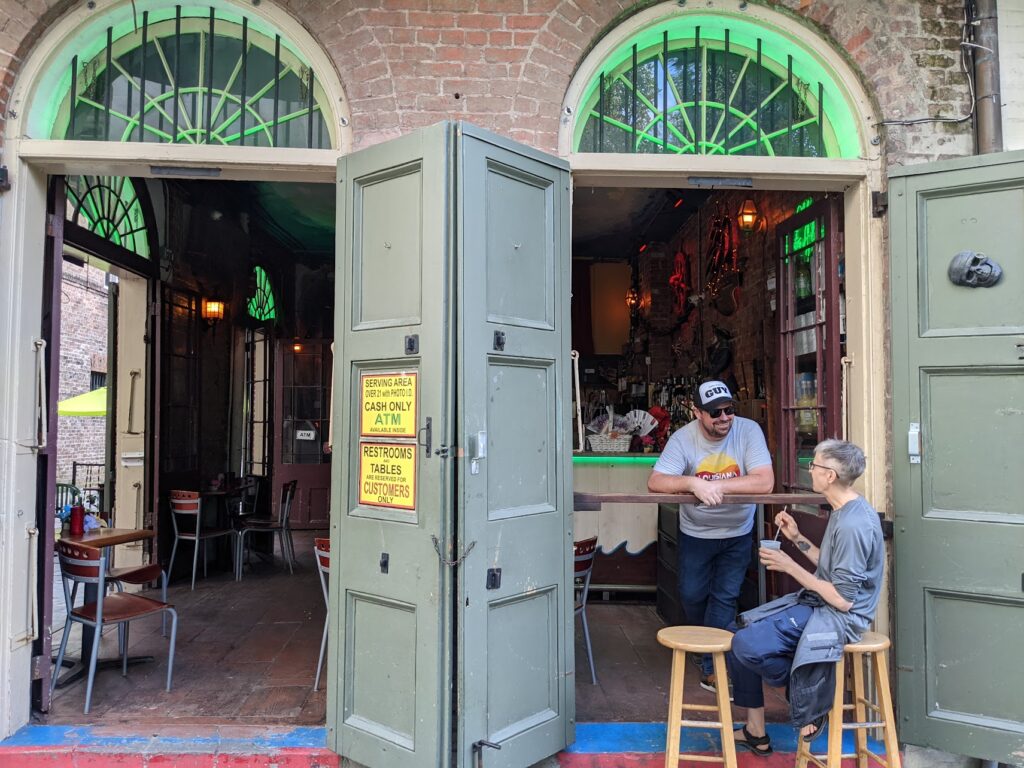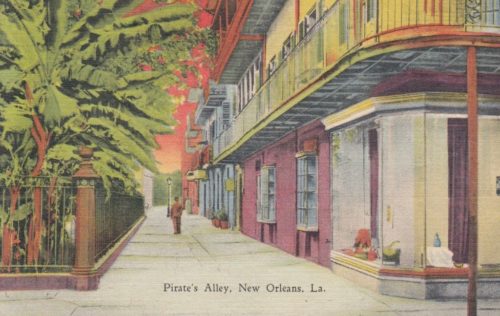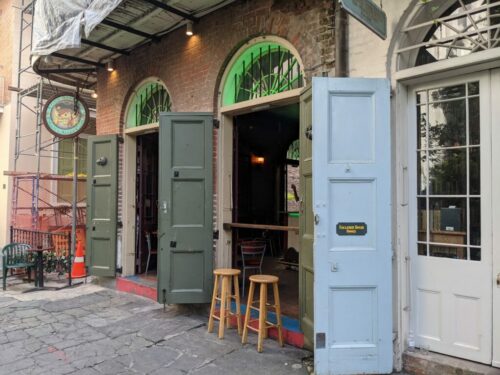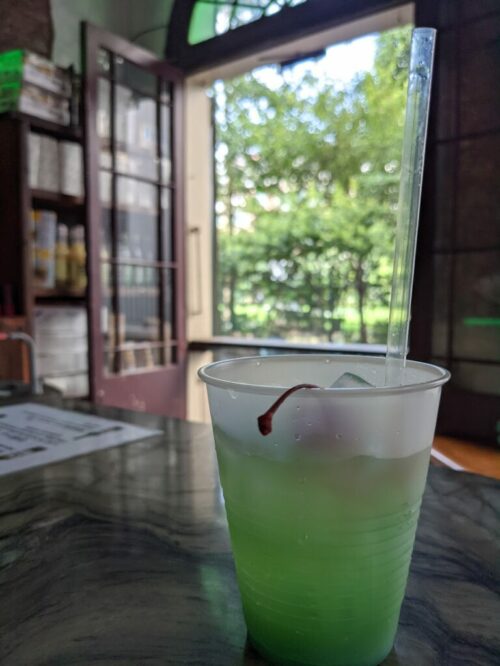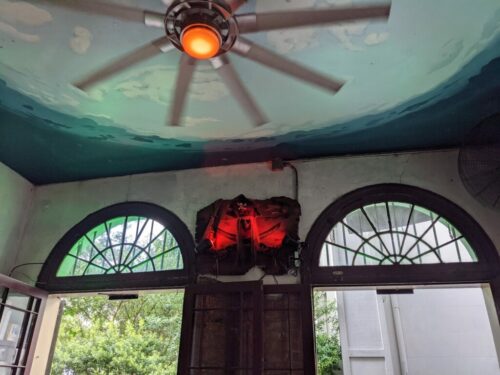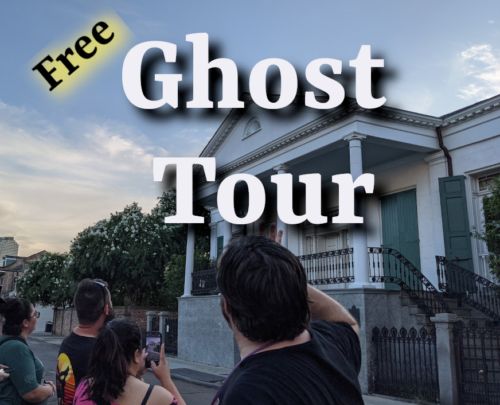Pirates Alley New Orleans
New Orleans is home to unusual street names, and many residents will offer their take on why a street has its moniker. Many wonder who was General Diaz. I once saw a flier for a party on the street proclaiming it was named after a Mexican dictator Porfirio Díaz and not the Italian World War I commander Armando Diaz. Neron Place still remains a mystery to this author and everyone I have asked along with Mystery Street. Meanwhile, Zimpel should be spelled Zimple after the Prussian engineer who helped lay uptown’s streets, but the street was misspelled and damn it we are sticking to it.
Why is it called Pirates Alley?
And then there is Pirates Alley. Hardly a road, but rather a short path some 600 feet long and at most 16 feet wide (shorter than some great white sharks and about the length of the largest tiger sharks) that today runs from the Charters pedestrian mall to Royal Street. The alley is well known to locals because of its colorful history, scenic appearance, and the continuing debate over what the name even means.
Before 1964 it was called Orleans Alley South. Officially that is. Official names though can be ignored by locals who refuse to forget older names or just prefer a more colorful rendering. It was called Pirates Alley and even had a sign saying that before 1964.
Where did the name Pirates Alley come from? The current legend says Jean Lafitte and Baratarian pirates (for the record, Lafitte insisted he was a privateer and no mean pirate) would meet there. Or sell their goods. It is unlikely. For one, Jean did not spend that much time in New Orleans, leaving city business to his savvy brother Pierre. The alley is flanked by St. Louis Cathedral (or is it more a basilica?) and the Cabildo. The latter is where the Spanish government met when they ruled Louisiana (which they spelled (Luisiana) from 1766-1803 (they were given Louisiana in 1762 but were so unexcited they didn’t arrive until 1766 and then got kicked out for a spell). The current Cabildo was only briefly in Spanish use, but throughout the era they jailed criminals behind the Cabildo. The Americans jailed many of Lafitte’s men in 1814, that is, until the British came to take the city and Andrew Jackson decided he needed every fighting man in the ranks.
While the jail being there is most likely, it is not the only possibility. By another account, the Catholic Church, eager to buy cheap goods, allowed the pirates to sell or at least receive sanctuary in the church. And to be fair, until 1814 the pirates operated with relatively little interference, as they had many prominent friends and allies. Regardless, the pirates sold their wares throughout Louisiana, not just New Orleans. A 1924 newspaper article from Monroe, Louisiana claimed the area got its name from pirates being executed there, but it provided no evidence.
The name seemed to have first shown up, at least in print, in New Orleans in 1926 when The Pirate’s Chest Gift Shop and Tea Room declared they were in Pirate’s Alley (and later said they were in Pirate Alley). Perhaps they gave it the name to harken back to the days of Lafitte, or simply went with what was already a local nickname. Regardless, in 1964 it received the official name Pirates Alley. Nearby Orleans Alley North was dubbed Père Antoine Alley, after a prominent Catholic of the 1800s.
William Faulkner, Pirates Alley most famous resident.
If one wanted to be more accurate, it might be called Faulkner Alley. William Faulkner lived there in 1925 and wrote his first short stories, collected in New Orleans Sketches. He also wrote his first novel, Soldiers’ Pay. He left in 1926, but New Orleans is where he was first published and his second novel Mosquitoes was set in the city, and he also contributed to the hilarious Sherwood Anderson & Other Famous Creoles (there are precious few Creoles in the book and Anderson was from Ohio, the least Creole spot in America). Faulkner’s presence was fitting. The alley is one of the most painted and photographed in the city. Artists sell paintings, to the rear of the St. Louis Cathedral along the iron fence of St. Anthony Garden, fittingly right near the aptly named Faulkner House Books.
Is Pirates Alley Worth Visiting?
Is, Pirates Alley worth visiting today? Of course! Onereason to go to Pirates Alley is the venerable Pirates Alley Café & Olde Absinthe House, owned by Thais Solano and Tony Seville. It is not a café. No food is served there and for that reason it was nearly closed in 2016 by the Department of Permits and Safety. Thankfully, under local pressure the department granted them a bar license. The bar has a pirate and nautical theme and is known as the best place in New Orleans to drink absinthe and absinthe cocktails such as death in the afternoon, obituary, and Russian funeral. You may notice a trend in the naming convention of the cocktails. However, like many other great bars of the French Quarter it is cash only, much like Aunt Tiki’s (which does not serve Tiki drinks just as much as Pirates Alley Cafe has no food). Pirates Alley Café & Olde Absinthe House is said to be the closest bar to an active church in America. It is only 14 feet, the length (a bit longer than a massive bull shark). Before April 2020 the bar opened a little early on Sunday and a few churchgoers could be spied inside laughing at the nearby Quiet: Church Zone sign. We love Pirates Alley so much two of our tours meet there, our Cocktail Tour and our Ghost Tour.
Is Pirates Alley Haunted?
I think you could ask the question if a place is haunted about literally anywhere in New Orleans and Pirates Alley is no exception. There is today a legend of a pirate ghost that wanders the alley late at night. Perhaps he does, but if so, no one knows his name. So guides will say it is Jean Lafitte. Or a pirate who escaped the jail only to be killed by a double-crossing guard once he was paid. Others just joke that it is merely a drunk spying on one of the quarter’s many people dressed as pirates. Of greater worry for anyone intoxicated though are the uneven cobblestones. Some say Faulkner’s ghost haunts the bookstore. Or the people imprisoned by the Union army in the nearby arsenal wander the area. Still another tale is a pirate named Reginald Hicks, who was married right outside the jail by an imprisoned German priest, only to die in the War of 1812. Keep in mind Hicks is mentioned at no point in William C. Davis’ The Pirates Laffite. Truth is, no one will ever really know or stop speculating, about anything to do with Pirates Alley.
To learn more about Pirates Ally take the cocktail tour. The history of absinthe is discussed along with other cocktails associated with New Orleans
The alley’s legends are discussed in the ghost tour

